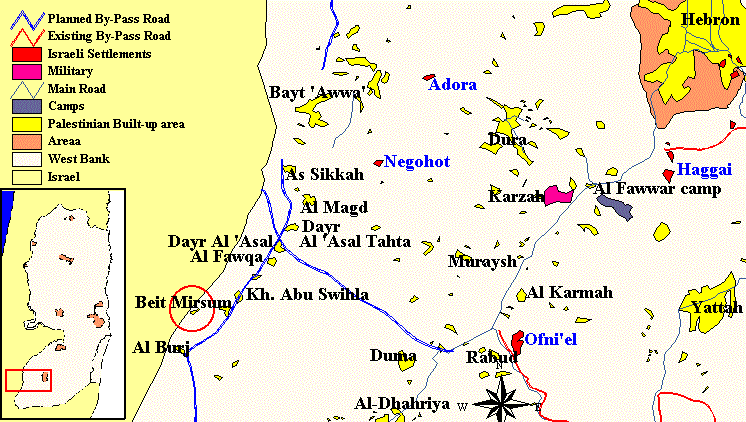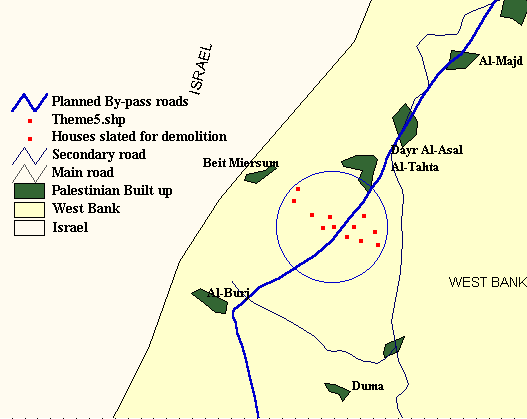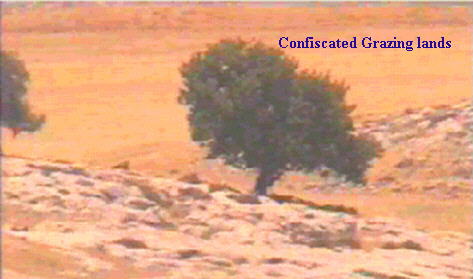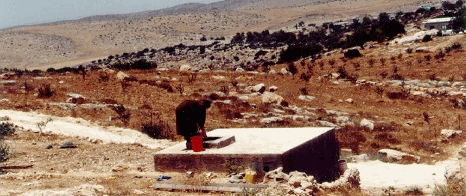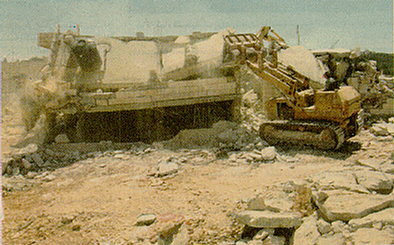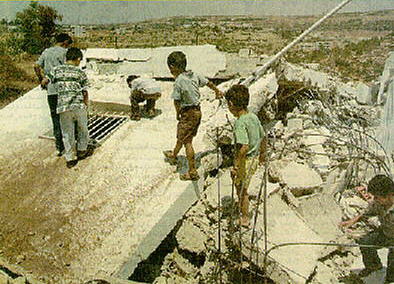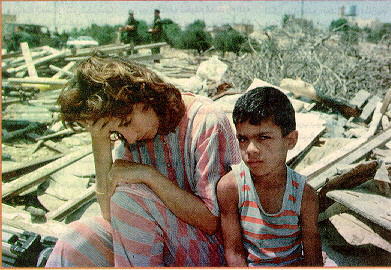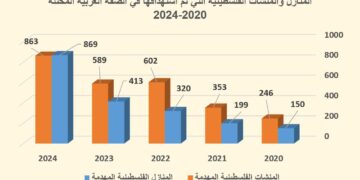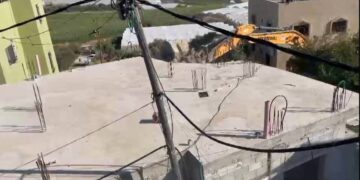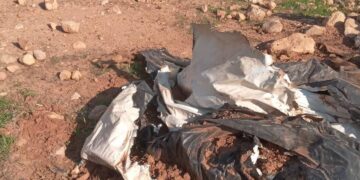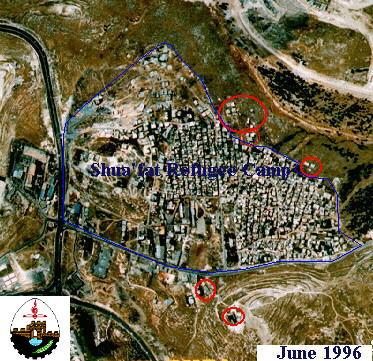Beit Marsam is a small village located in the southern part of the Hebron district, less than half a kilometer east of the West Bank border with Israel, the 'Green line' (Figure 1). In 1952, the village supported a population of approximately 1,000 people. Presently, however, only about 200 people live in the village. This decrease in population is due to the strict limitations placed on construction and development in the village by Israel. ). In 1952, the village supported a population of approximately 1,000 people. Presently, however, only about 200 people live in the village. This decrease in population is due to the strict limitations placed on construction and development in the village by Israel.
Figure 1: Location map of Beit Marsam
During the 1967 war, the village school and all existing houses were destroyed by Israel, forcing the inhabitants to leave the area. When they were allowed to return, the Israeli administration established strict guidelines stipulating the extent to which they could rebuild their houses and community. Only 33 houses, of one room each, were permitted to be rebuilt (Figure 2). As a consequence, many families were not able to return to their village. Families who did return found themselves, on average, with seven to eight people living in one room. This situation has continued into the present day. Hence, the shortage of housing and overcrowded living conditions have caused a dramatic decline in the village population.). As a consequence, many families were not able to return to their village. Families who did return found themselves, on average, with seven to eight people living in one room. This situation has continued into the present day. Hence, the shortage of housing and overcrowded living conditions have caused a dramatic decline in the village population.
Figure 2: The existing one-room houses of Beit Marsam
According to the 1995 Israeli Palestinian Interim Agreement (Oslo II), Beit Marsam village was placed within Area C, which is under full Israeli control though still within the Green Line. As a policy, Israel has so far denied Palestinians building permits to build houses on their land if it lies within Area C. Israel has also evicted many Bedouin tribes who resides in Area C. These measures aim to empty Area C of its Palestinian residents in order to facilitate its annexation to Israel, an action which is in direct violation of international agreements and the standing Israeli Palestinian Agreement (Oslo II). In a similar fashion, the residents of Beit Marsam village were rejected building permits by Israel to expand their one-room houses and build additional ones. The inevitable need for more housing to absorb the growing population compelled the village residents to build 12 new houses on land belonging to the village without the approval of Israel (Figure 3). ).
Figure 3: The location of the 12 new houses in the Beit Marsam village
Recently, Israel notified the owners of the newly build houses that these houses are illegal and are slated for demolition (Figure 4). The orders were issued on the 13 January 1997 and are expected to be carried out at any time.). The orders were issued on the 13 January 1997 and are expected to be carried out at any time.
Figure 4: One of the houses slated for demolition in Beit Marsam
Furthermore, Israel has recently confiscated around 50 hectares of the village land and has granted it to an Israeli settler (recognized by the villagers as the son-in-law of the Israel Minister of Infrastructure, Ariel Sharon) to establish a farm (Figure 5). ).
Figure 5: Grazing Land confiscated from the Beit Marsam village
Israeli restrictions on building and the confiscation of village land has induced economic and social hardship on the Palestinian villagers of Beit Marsam. Economically, the majority of villagers, who are mostly farmers, have lost their livelihood and communal lands used for grazing their sheep and goats. Farmers may consequently be forced to sell their livestock due to the lack of grazing lands.
The packing of seven to eight people in one-room houses in Beit Marsam has imposed serious consequences on the living environment. This is especially critical when we consider that the village has no infrastructure such as piped water systems, electricity, or a sewage disposal network. As of today, Beit Marsam villagers use 'toilets' outside of their homes where sewage is absorbed into the ground (holes are dug for these 'toilets' and used as cesspits). This has detrimental effects on the health of the villagers as it heightens the risk of contracting diseases and polluting water cisterns which provide the main source of water for the villagers (Figure 6). ).
Figure 6: A woman from Beit Marsam filling her bucket with water from a water cistern
The village of Beit Marsam is not the only village affected by land confiscation and house demolitions. Around 3,400 houses in Area C of the West Bank and in East Jerusalem are presently slated for demolition by Israel (Figure 7), (8), (9), and (10).
Figures 7: Israel demolishing the house of the Kurshan family in Shua'fat Refugee Camp in East Jerusalem (From Al-Quds Newspaper, Tuesday 5 August 1997, Issue No. 10037)

Figure 8: Israeli bulldozer demolishing the house of the Odeh family in Al-Ezariya (From Al-Quds Newspaper, Tuesday 5 August 1997, Issue No. 10037)
Figure 9: Children checking the rubble of a demolished Palestinian house belonging to
the Shamasneh family in Qattana village (From Al-Quds Newspaper, Friday 8 August 1997, Issue No. 10040)
Figure 10: A Palestinian women sitting besides her young brother at the rubble of their house which Israel demolished (From Al-Quds Newspaper, Wednesday 15 August 1997, Issue No. 10047)
Such massive demolition of Palestinian houses indicates a systematic plan of ethnic cleansing of Area C from its Palestinian inhabitants. The construction of Israeli By-Pass roads, similar to those along the eastern side of Beit Marsam village, also contribute to the isolation of Palestinian communities and further limit their development. The overall Israeli plan behind these measures was recently expressed in the Israeli unilaterally proposed 'Allon Plus' plan for the settling of the Israeli-Palestinian territorial dispute ((Figure 11).).
Figure 11: The Israeli Allon Plus Plan for the 'Final Status' solution of the Israeli Palestinian conflict.
This proposal clearly demonstrates the intention of Israel to annex Beit Marsam village land and the surrounding proximity through a significant alteration of the Green line. Several areas in the West Bank are subjected to similar alterations. The overall plan calls for the retaining of over 55% of the West Bank under full Israeli control and only 45% will be returned to the Palestinian Authority. This would violate the legal requirements of the United Nations Declaration on Principles of International Law Governing Friendly Relations and Co-operation Among States, which states in Resolution 2526 (XXV):
'Every State likewise has the duty to refrain from the threat or use of force to violate international lines of demarcation, such as armistice lines, established by or pursuant to an international agreement to which it is a party or which it is otherwise bound to respect.'
By threatening to shift the Green Line and confiscating further land in the West Bank, the Israeli initiative will directly compromise international agreements. Similarly, the more than 700 Km of by-pass roads, like those around the village of Beit Marsam, which cut through agricultural and grazing lands also violates the Interim Agreement of Oslo II (1992) which states in Article XXXI.7:
'Neither side shall initiate or take any step that will change the status of the West Bank and the Gaza Strip pending the outcome of the permanent status negotiations.'
Prepared by
The Land Research Center
LRC


